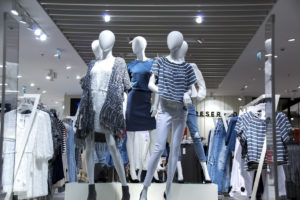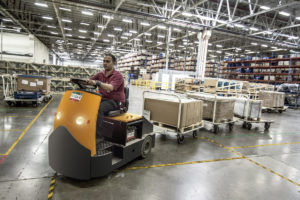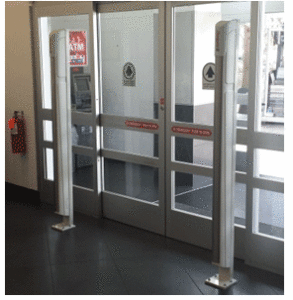 Holiday sales events and promotions are intended to boost retail sales. The obvious big event is the Christmas holiday season which seems to begin in October for many retailers. The event carries into January when merchandise goes clearance as retailers prepare for the next holiday event and the beginning of the Spring sales lines. During the remainder of the year, retailers also take advantage of other holidays by appealing to customers. These events just are not as extravagant in terms of time or advertising. Clothing stores conduct promotions at Easter to sell dresses, suits and related accessories. Grocery stores and discount retailers run special deals on candy, eggs, toys, and baskets. The 4th of July sales may be geared towards parties, cookouts, and summer themed goods like bathing suits. The sales don’t necessarily have anything to do with the holiday being celebrated they simply entice customers to come in for the low prices. Below are a few ads I found online for previous Memorial Day sales to illustrate my point:
Holiday sales events and promotions are intended to boost retail sales. The obvious big event is the Christmas holiday season which seems to begin in October for many retailers. The event carries into January when merchandise goes clearance as retailers prepare for the next holiday event and the beginning of the Spring sales lines. During the remainder of the year, retailers also take advantage of other holidays by appealing to customers. These events just are not as extravagant in terms of time or advertising. Clothing stores conduct promotions at Easter to sell dresses, suits and related accessories. Grocery stores and discount retailers run special deals on candy, eggs, toys, and baskets. The 4th of July sales may be geared towards parties, cookouts, and summer themed goods like bathing suits. The sales don’t necessarily have anything to do with the holiday being celebrated they simply entice customers to come in for the low prices. Below are a few ads I found online for previous Memorial Day sales to illustrate my point:
- A furniture store: $1 Down and 60 months no interest
- A Home Improvement store: 10% – 30% Off Major Appliances $396 or more
- A Car Dealership: Memorial Day 100 Sale – Payments as low as $100/month
- A Grocery Store: Big Three Day Sale
Many of the ads feature red, white and blueprint as well as stars and stripes in attempts to appeal to the patriotism of potential shoppers. I understand the need for merchants to do everything they can to increase sales. Retail is competitive and in order to stay in business owners must take advantage of opportunities as they arise.
What I would like to suggest is that retailers look more closely at the holiday they are running promotional campaigns for. Try to see if there is some way to honor the holiday, specifically Memorial Day. I am suggesting that if a retailer is holding a Memorial Day sale they take the opportunity to honor the fallen soldiers for whom the day is remembering. This is no easy undertaking. I have seen restaurants that have attempted to recognize the sacrifices of the fallen with discounts and free meals for military veterans. Despite the good intentions, they get grief from some people (I assume they are veterans) who chastise them for not recognizing the difference between Memorial Day and Veteran’s Day. As a veteran, I appreciate the effort shown and think that the griping is misplaced. There are few ways they can recognize fallen heroes but a meal or discount is the form of appreciation they can offer.
What can a retailer do then to promote sales and keep to the spirit of the Memorial Day holiday? I would like to offer the following ideas:
- Offer a portion of each transaction to a non-profit agency that provides assistance to the widows and children of veterans who have fallen in combat. Just a few of the groups that help such families include:
Fallen Patriot Fund
www.fallenpatriotfund.org
Faces of Valor USA
http://www.facesofvalorusa.org/
Children of Fallen Soldiers Relief Fund
These are just three organizations that provide such assistance and there are many more out there.
- While it has been the source of some contention you could consider offering a discount of 10% or greater to service members or veterans who can show a military ID or a copy of a DD 214 form (a document that shows a veteran has served).
- Consider setting up a display for Memorial Day, often called a Fallen Soldier Table, a White Table or a Missing Man Table. The effort will not go unnoticed by those who have served or the family members of fallen soldiers. The displays are not difficult to prepare https://www.veteranscaucus.org/index.php/events/memorial-day/america-s-white-table
- If taking a portion of a day’s sales is not in your budget, a donation can or collection jar with a designated charitable organization listed is an appropriate alternative.
- Finally, invite a veteran’s group such as the VFW (Veterans of Foreign Wars) to hand out poppies for a donation at your store. https://www.vfw.org/community/community-initiatives/buddy-poppy
The VFW uses the money collected to provide financial assistance in maintaining state and national veteran’s rehabilitation and service programs and partially supports the VFW National Home for Children.
The ideas are certainly not all-inclusive and you may find some other source of recognition of the sacrifices made by our fallen heroes. The point is that you honor the day and what it represents as you still run your sales and specials. Remember those who have made it possible for you to operate your business in a free country.
 What do you do when a crisis occurs? Many people would say they take steps to address the crisis. Initially, that may sound like a good response unless you never planned on how you would react if that crisis were to take place. Think about it for a moment. If your business was on fire would you want firemen pulling up in their cars without the right gear or a plan of action of how they will take care of the fire? Sure it’s good to have the firemen there but if they don’t have the resources they need or a strategy on how to put out a house fire then the response is pointless. Police officers train on how to respond to a bank robbery in progress but the reality is many officers will never face that situation. According to a Cleveland Clinic Survey, 54% of Americans say they know CPR but the vast majority of us will never be called upon to use that training. So why do we do it? Why do we train for circumstances that are unlikely to ever confront us? We do it so we will be prepared for that one-in-a-million chance that we might have to apply that knowledge. President John F. Kennedy once said, “The time to repair the roof is when the sun is shining.” Attempting to play it by ear should an emergency happen is not a plan and may even make a problem worse.
What do you do when a crisis occurs? Many people would say they take steps to address the crisis. Initially, that may sound like a good response unless you never planned on how you would react if that crisis were to take place. Think about it for a moment. If your business was on fire would you want firemen pulling up in their cars without the right gear or a plan of action of how they will take care of the fire? Sure it’s good to have the firemen there but if they don’t have the resources they need or a strategy on how to put out a house fire then the response is pointless. Police officers train on how to respond to a bank robbery in progress but the reality is many officers will never face that situation. According to a Cleveland Clinic Survey, 54% of Americans say they know CPR but the vast majority of us will never be called upon to use that training. So why do we do it? Why do we train for circumstances that are unlikely to ever confront us? We do it so we will be prepared for that one-in-a-million chance that we might have to apply that knowledge. President John F. Kennedy once said, “The time to repair the roof is when the sun is shining.” Attempting to play it by ear should an emergency happen is not a plan and may even make a problem worse. The scary shoplifting cases we hear and see on TV, or on newspapers in the United States, are becoming too commonplace to rendered us shocked.
The scary shoplifting cases we hear and see on TV, or on newspapers in the United States, are becoming too commonplace to rendered us shocked.  Sometime this year you will most likely be conducting an inventory. Some stores even conduct multiple inventories when they have high stock shortage results. While it does not necessarily translate to poor results, a lack of adequate preparation can have an impact on the final shortage numbers.
Sometime this year you will most likely be conducting an inventory. Some stores even conduct multiple inventories when they have high stock shortage results. While it does not necessarily translate to poor results, a lack of adequate preparation can have an impact on the final shortage numbers. Many small and big chain businesses across the country are fed up with the amount they lose due to shoplifting and employee theft.
Many small and big chain businesses across the country are fed up with the amount they lose due to shoplifting and employee theft. Because like alcohol abuse, both legal and illegal drug use, affects your bottom line. This issue
Because like alcohol abuse, both legal and illegal drug use, affects your bottom line. This issue  As managers and supervisors, we are all guilty at some point of assuming our employees will know what we are wanting from them when we make a request or assign a project. It may be something as simple as asking someone to empty a trash canister or as complicated as resetting a plan-o-gram. In our minds, the requested task may only require common sense but to the employee, it may be something totally different. Take the trash can example, you may ask an employee to empty it and assumed they would empty it into a compactor and place a new trash can liner inside. The employee may only hear that you want them to take the bag out and place the trash beside the compactor. They don’t hear you tell them to put a new liner inside the canister when they are done because you never said it. It seems like it should only be common sense but it isn’t necessarily the case. The same problem exists for every aspect of a job. Sometimes those of us in management positions make unfair assumptions and then get angry when our team members don’t do what we expected them to do.
As managers and supervisors, we are all guilty at some point of assuming our employees will know what we are wanting from them when we make a request or assign a project. It may be something as simple as asking someone to empty a trash canister or as complicated as resetting a plan-o-gram. In our minds, the requested task may only require common sense but to the employee, it may be something totally different. Take the trash can example, you may ask an employee to empty it and assumed they would empty it into a compactor and place a new trash can liner inside. The employee may only hear that you want them to take the bag out and place the trash beside the compactor. They don’t hear you tell them to put a new liner inside the canister when they are done because you never said it. It seems like it should only be common sense but it isn’t necessarily the case. The same problem exists for every aspect of a job. Sometimes those of us in management positions make unfair assumptions and then get angry when our team members don’t do what we expected them to do. A Target or Walmart store can and are able to fight shoplifting in their stores every day of the year.
A Target or Walmart store can and are able to fight shoplifting in their stores every day of the year. I actually like and believe in all three of these things. When it comes to drugs they have to be the legal kind. All of us have seen the destruction that illegally used drugs cause. In a business environment, illegal drug use by an employee not only has an impact on their work performance but creates serious customer and legal issues for employers. An employee that is under the influence of any substance that influences their ability to do their job correctly or safely, will cause customers to question who they are doing business with.
I actually like and believe in all three of these things. When it comes to drugs they have to be the legal kind. All of us have seen the destruction that illegally used drugs cause. In a business environment, illegal drug use by an employee not only has an impact on their work performance but creates serious customer and legal issues for employers. An employee that is under the influence of any substance that influences their ability to do their job correctly or safely, will cause customers to question who they are doing business with. With darker daylight hours comes the need for more coffee, the use of lights earlier and a plan to keep crime away from your store or business. Have you considered that one of the following types of crime could affect you?
With darker daylight hours comes the need for more coffee, the use of lights earlier and a plan to keep crime away from your store or business. Have you considered that one of the following types of crime could affect you?
